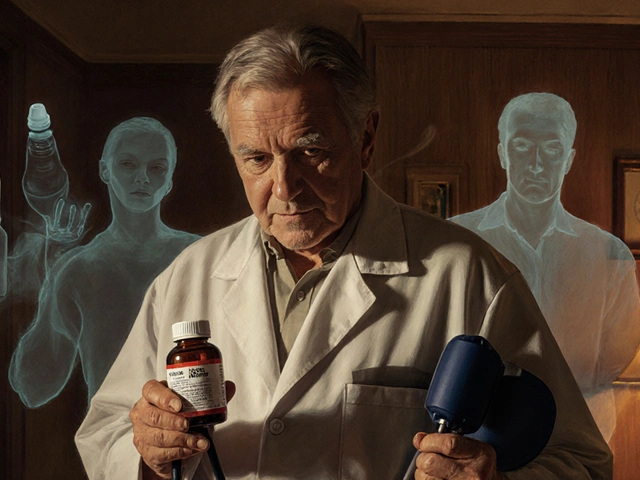You clicked this because you want straight answers: what is Bupron SR, what does it treat, how do you take it, and what should you watch for? Here’s the short version-this is bupropion sustained‑release, a medicine widely used for depression and sometimes for quitting smoking, with a few important “watch-outs” like seizure risk and drug interactions. Expect energy and concentration to lift first; mood follows. It’s usually taken once daily for a few days, then twice daily, with strict spacing between doses.
- Bupron SR = bupropion SR. It’s an NDRI antidepressant (boosts norepinephrine and dopamine).
- Common uses: Major depression; also used for smoking cessation (brand Zyban in many countries).
- Typical dosing: 150 mg in the morning for 3 days, then 150 mg twice daily (≥8 hours apart). Max SR dose usually 400 mg/day.
- Key risks: seizures (rare, dose-related), high blood pressure, insomnia, anxiety; avoid if you have a seizure or eating disorder history.
- Interactions: potent CYP2D6 inhibitor (affects drugs like metoprolol, tamoxifen, many antidepressants); never mix with MAOIs.
What Bupron SR is, who it’s for, and how it works
Bupron SR is a sustained‑release (twice‑daily) form of bupropion, an antidepressant in the NDRI class. Unlike SSRIs, bupropion has little direct effect on serotonin. That difference matters for side effects: it tends to be more activating and is less likely to cause weight gain or sexual dysfunction. Many people feel a lift in energy and focus within 1-2 weeks, while mood and enjoyment often catch up by weeks 3-6.
Core indications and context:
- Major Depressive Disorder (MDD): Common first‑line option in several clinical guidelines when an activating profile is acceptable.
- Smoking cessation: The same compound is marketed as Zyban in many countries; started 1-2 weeks before quit date and continued for 7-12 weeks.
- Seasonal affective disorder: Typically the extended‑release (XL) form is studied; SR may be used when XL isn’t available.
Where you live can shape access. For example, in New Zealand, bupropion is available for smoking cessation (Zyban). Use for depression may be off‑label and funding can vary-always check with your local prescriber or pharmacist.
“Bupropion hydrochloride is associated with a dose‑related risk of seizure; the risk can be reduced if the dose does not exceed recommended limits and the titration rate is gradual.” - U.S. FDA, Wellbutrin SR Prescribing Information
Why choose it (or not):
- May help when low energy, poor concentration, and fatigue are a big part of depression.
- Lower risk of sexual side effects; sometimes used to counter SSRI‑related sexual dysfunction.
- Weight‑neutral on average; mild weight loss can occur.
- Can worsen anxiety or insomnia in some; not ideal if you’re already jittery or have panic attacks.
- Contraindicated if you have a seizure disorder, current or past bulimia/anorexia nervosa, or you’re stopping alcohol/benzodiazepines abruptly.
| Use | Typical SR Dose | Target Timing | Max SR Dose | Notes |
|---|---|---|---|---|
| Major depression | 150 mg AM x 3 days; then 150 mg twice daily (≥8 hrs apart) | AM and mid‑afternoon (avoid late evening) | 400 mg/day (200 mg BID) | Energy/concentration may improve in 1-2 weeks; mood 3-6 weeks |
| Smoking cessation (Zyban protocol) | 150 mg daily x 3 days; then 150 mg twice daily | Start 1-2 weeks before quit date; continue 7-12 weeks | 300 mg/day common; some go to 400 mg with caution | Combining with nicotine patch increases BP risk; monitor |
| Hepatic impairment | Consider 150 mg daily (mild) or 150 mg every other day (moderate‑severe) | AM preferred | Individualised | Accumulates; increases adverse effects |
| Renal impairment | Consider 150 mg daily | AM | Individualised | Metabolites accumulate; go slow |
Seizure risk is dose‑related. In SR studies, seizures occurred in about 0.1% of people at ≤300 mg/day and about 0.4% at 400 mg/day. That’s why prescribers insist on gradual titration and spacing doses at least eight hours apart.

Safe use: dosing, titration, side effects, and interactions
Here’s a practical, step‑by‑step way to start and stay safe.
- Before starting
- Tell your clinician if you’ve ever had a seizure, head injury, brain tumour, or an eating disorder (bulimia/anorexia). These are red flags.
- List every medicine and supplement you take. Bupropion strongly inhibits CYP2D6. That can raise levels of metoprolol, many SSRIs/SNRIs, tricyclics, antipsychotics, and can reduce the effectiveness of tamoxifen.
- Check your blood pressure baseline. Bupropion can raise BP, especially with nicotine replacement.
- No MAOIs within 14 days (including linezolid or IV methylene blue). This is non‑negotiable.
- Discuss pregnancy or breastfeeding plans. Data are mixed but generally reassuring; decisions are individual.
- How to take it
- Swallow SR tablets whole. Do not crush, split, or chew (that can spike levels and raise seizure risk).
- Start 150 mg each morning for 3 days. Then increase to 150 mg twice daily, with at least 8 hours between doses. Many do well at 300 mg/day; some may go to 400 mg/day if needed and tolerated.
- Avoid late‑evening dosing-it can cause insomnia. I set a reminder on my phone right after lunch so I don’t push it too late (and yes, I time it around feeding my cat so I don’t forget).
- If you miss a dose and it’s close to bedtime, skip it. Don’t double up.
- For smoking cessation
- Choose a quit date 1-2 weeks in the future. Start 150 mg daily for 3 days, then 150 mg twice daily.
- Continue for 7-12 weeks. Consider combining with behavioural support; it significantly boosts success rates.
- If using nicotine patches or gum, monitor blood pressure weekly at first. Headache or palpitations? Check BP the same day.
- While on treatment
- Week 1-2: watch for activation (nervousness, insomnia), dry mouth, nausea, headache. Often transient.
- Week 3-6: look for mood gains-less hopelessness, better interest and drive.
- Track sleep, appetite, and energy with a simple daily note. It helps you and your clinician adjust dose early.
- Check BP if you get headaches, dizziness, or feel “wired.”
- When to call your clinician urgently
- Any seizure activity or loss of consciousness-call emergency services.
- Severe anxiety, agitation, or new suicidal thoughts-same‑day contact.
- Allergic reactions (rash, swelling, breathing issues).
- Severe high blood pressure symptoms: pounding headache, chest pain, vision changes.
Common side effects and what they feel like:
- Insomnia and vivid dreams: move the second dose earlier; cut back on late coffee.
- Dry mouth: keep water handy; sugar‑free gum helps.
- Nausea: take with a light meal or snack.
- Anxiety/jitteriness: often settles; if not, discuss slowing titration or adjusting the dose.
- Headache or BP up: check blood pressure. If elevated, call your prescriber.
| Adverse effect | Approximate frequency | Tips |
|---|---|---|
| Insomnia | ~10-20% | Take doses earlier; avoid evening caffeine; consider sleep hygiene adjustments |
| Dry mouth | ~10-15% | Hydration, sugar‑free gum/lozenges |
| Nausea | ~10% | Take with food; smaller, more frequent meals |
| Tremor, anxiety | ~2-10% | Slow titration; review caffeine and other stimulants |
| Blood pressure rise | Uncommon; higher with nicotine patch | Baseline and periodic BP checks; adjust therapy if needed |
| Seizure | ~0.1% at ≤300 mg/day; ~0.4% at 400 mg/day | Do not exceed dose; space doses ≥8 hours; avoid risk factors |
Major interactions (speak up if you’re on any of these):
- MAOIs: absolute no. 14‑day washout both ways.
- Drugs that lower seizure threshold: tramadol, theophylline, antipsychotics, systemic steroids, some quinolones-extra caution.
- CYP2D6 substrates: metoprolol, many antidepressants (e.g., venlafaxine, paroxetine), tricyclics, some antipsychotics-levels can rise; dose changes may be needed.
- Tamoxifen: bupropion can reduce active endoxifen; avoid combination if possible-oncology input is key.
- Alcohol: heavy use raises seizure risk; avoid binges and abrupt withdrawal.
Special populations:
- Pregnancy: Large observational data are generally reassuring for major malformations, though signals for certain heart defects have been reported in some analyses. Shared decision‑making is essential.
- Breastfeeding: Low levels in milk; infants should be observed for irritability or poor feeding.
- Bipolar spectrum: Antidepressants can trigger mania/hypomania; screen history and consider mood stabilizer cover where appropriate.
- Glaucoma risk: Rare angle‑closure events in predisposed people; get urgent help if you have sudden eye pain and vision changes.

Practical scenarios, checklists, and answers you’ll actually use
Real‑life situations come up; here’s how clinicians usually handle them.
If you’re switching from an SSRI due to sexual side effects:
- Option A: Add bupropion SR 150 mg AM while staying on the SSRI; reassess at 2-4 weeks. Many find libido and orgasm improve.
- Option B: Cross‑taper-introduce bupropion while gradually reducing the SSRI over 2-4 weeks. This can reduce withdrawal symptoms from the SSRI.
- Heads‑up: bupropion can increase levels of some SSRIs via CYP2D6; dose tweaks may be needed.
If sleep is wrecked:
- Shift the second dose to early afternoon (e.g., 1-2 p.m.).
- Cut afternoon caffeine. Protect a 30‑minute wind‑down off‑screens before bed.
- If insomnia persists, talk to your clinician about dose timing or considering the XL morning‑only version.
If anxiety spikes on day 3-10:
- Pause at 150 mg daily for a week before increasing. Many settle with time.
- Check for caffeine, decongestants, and energy drinks-they amplify activation.
- Brief, as‑needed non‑sedating strategies (walks, breathing drills) help while the body adapts.
Cheat‑sheet: before you start
- Seizure/eating disorder history? If yes, do not start.
- Any MAOI or linezolid/methylene blue? If yes, do not start.
- On tamoxifen? Discuss alternatives.
- Baseline BP noted? Yes-good.
- Plan for dose timing and reminders in place? Great.
Cheat‑sheet: while you’re on it
- Space doses by ≥8 hours; avoid evening dosing.
- Hydrate for dry mouth; take with food if nauseated.
- Monitor mood weekly; small notes beat fuzzy memory.
- Report severe anxiety, suicidal thoughts, rash, or any seizure immediately.
Mini‑FAQ
- Is Bupron SR the same as Wellbutrin SR? Yes, same active ingredient (bupropion SR). Brand names vary by country.
- Can I split the SR tablet? No. Swallow whole. Splitting defeats the slow‑release design and raises seizure risk.
- How long until I feel better? Energy/concentration in 1-2 weeks; mood 3-6 weeks. Give it time unless side effects are severe.
- Weight change? Often neutral; mild weight loss is possible.
- Sexual side effects? Lower risk than SSRIs; may improve SSRI‑related dysfunction.
- Can I drink alcohol? Light, consistent intake may be tolerated, but bupropion plus binges or withdrawal raises seizure risk. Many clinicians advise avoiding alcohol, especially early on.
- Driving or operating machinery? Until you know how you respond (dizziness, agitation), be cautious.
- SR vs XL vs IR? SR is twice daily; XL is once daily; IR is three times daily and used less now due to peaks and side effects.
- Do I need to taper when stopping? Bupropion has less withdrawal than SSRIs, but many still taper over 1-2 weeks to avoid rebound anxiety or sleep issues.
Credible sources clinicians rely on: FDA Wellbutrin SR Prescribing Information; Medsafe data sheet for Zyban; CANMAT guideline for MDD; Cochrane reviews on smoking cessation (which consistently show higher quit rates with bupropion vs placebo).
Next steps / Troubleshooting
- If you’re just starting: set dose reminders now, pick stable dose times, and book a 2-4 week follow‑up for dose review.
- If you’re not feeling better by week 4-6: discuss the dose (some need 400 mg/day SR) or consider switching/augmenting.
- If side effects are loud: slow the titration, adjust timing, or consider the XL formulation. Review caffeine and other stimulants.
- If you’re on complex meds (e.g., tamoxifen, tricyclics, metoprolol): ask your clinician about drug level monitoring or dose adjustments due to CYP2D6 inhibition.
- If you’re planning pregnancy or breastfeeding: schedule a dedicated consult to weigh risks, benefits, and alternatives.
One last practical note from daily life: keep the bottle somewhere you can’t miss in the morning routine-next to the kettle works for me-and set a midday alarm for the second dose. Tiny systems beat willpower on busy days.
This guide is for education, not a diagnosis. Work with your healthcare professional for decisions tailored to you.






Written by Martha Elena
I'm a pharmaceutical research writer focused on drug safety and pharmacology. I support formulary and pharmacovigilance teams with literature reviews and real‑world evidence analyses. In my off-hours, I write evidence-based articles on medication use, disease management, and dietary supplements. My goal is to turn complex research into clear, practical insights for everyday readers.
All posts: Martha Elena